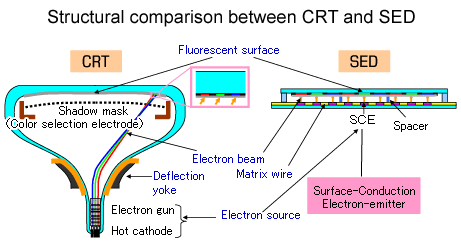SED (surface-conduction electron-emitter display) is a flat-panel, high-resolution display developed by Canon that will compete with LCD TV and plasma displays. SED is said to provide the picture quality of cathode-ray tube (CRT), in a flat-panel format, at about 50 percent of the power consumption of CRT displays and 33 percent of the power of plasma displays of a comparable size.
The SED consists of an array of electron emitters and a layer of phosphor, separated by a small space from which all the air has been evacuated. There is a dedicated electron emitter for each pixel in the display. The SED requires no electron-beam focusing, and operates at a much lower voltage than a CRT. The brightness and contrast compare favorably with high-end CRTs. Prototype electron emitters have been developed with diameters of a few nanometers (billionths of a meter), which could yield improved resolution.
Canon began SED research in 1986 and, in 2004,Toshiba television and Canon announced a joint development agreement originally targeting commercial production of SEDs by the end of 2005. The 2005 target was not met, and several new targets since then have also slipped by. This failure to meet mass-production deadlines goes as far back as 1999, when Canon first told investors of its intentions to immediately begin mass-producing the technology. The lack of tangible progress has worried many investors and has prompted many critics. One critic called SED “the best display technology you’ve ever seen that may be stillborn.” During the 2006 Consumer Electronics Show, Toshiba showed working prototypes of SEDs to attendees and indicated expected availability in mid-to-late 2006. Toshiba and Canon again delayed their plan to sell the television sets to the fourth quarter of 2007. At the 2007 Consumer Electronics Show in Las Vegas, Nevada, no SED displays were to be found on the show floor. This led many analysts to speculate that the technology would never reach the consumer market.
In October 2006, Toshiba’s president announced the company plans to begin full production of 55″ SED TVs in July 2007 at its recently built SED volume-production facility in Himeji.
In December 2006, Toshiba President and Chief Executive Atsutoshi Nishida said Toshiba is on track to mass-produce SED TV sets in cooperation with Canon by 2008. He said the company plans to start small-output production in the fall of 2007, but they do not expect SED displays to become a commodity and will not release the technology to the consumer market because of its expected high price, reserving it solely for professional broadcasting applications.
Nano-Proprietary SED-patents Lawsuit
Also in December of 2006, it was revealed that the delays in SED TV mass production were caused by litigation between Applied Nanotech, a subsidiary of Nano-Proprietary, and Canon. Nano-Proprietary claims that Canon broke an exclusivity agreement by sharing information related to electron emissions from carbon nanotubes with Toshiba. The litigation has been reportedly ongoing since April of 2006.
January 12, 2007, Toshiba announced an agreement by which Canon will purchase all of Toshiba’s outstanding share of the SED joint venture, in order to satisfy Nano-Proprietary’s complaints. This is also expected to prevent the litigation from dragging on in American courts. The company must purchase 50% of Toshiba shares to produce SED TVs on its own. Canon is still planning a release of SED displays in Japan during the 4th quarter of 2007, and will be ‘reassessing’ its future mass-production plans for SED panels.
February 22, 2007, Federal Judge Samuel Sparks, with the U.S. District Court for the Western District of Texas, ruled in a summary judgment that Canon violated its agreement with Texas-based Nano-Proprietary by forming a joint television venture with Toshiba.

Samsung Electronics has shown an interest in SED technology. Samsung is a very aggressive electronics giant with the goal of being the number one electronics company in the world. Currently, it offers DLP microdisplay, plasma, LCD, and CRT-based TVs. It plays in every TV arena. It is known that Samsung is exploring Carbon Nanotube (CNT) displays and OLED technology as replacements for current TV technology. So, it’s no surprise that it would also pursue SED, if it became available.
